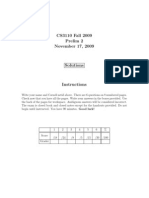AVL Tree
AVL Tree
Uploaded by
Manish MadhusoodhanCopyright:
Available Formats
AVL Tree
AVL Tree
Uploaded by
Manish MadhusoodhanOriginal Title
Copyright
Available Formats
Share this document
Did you find this document useful?
Is this content inappropriate?
Copyright:
Available Formats
AVL Tree
AVL Tree
Uploaded by
Manish MadhusoodhanCopyright:
Available Formats
AVL TREE:
It is one of the types of the binary tree, or we can say that it is a variant of
the binary search tree. AVL tree satisfies the property of the binary tree as well
as of the binary search tree. It is a self-balancing binary search tree that was
invented by Adelson Velsky Lindas. Here, self-balancing means that balancing the
heights of left subtree and right subtree. This balancing is measured in terms of
the balancing factor.
We can consider a tree as an AVL tree if the tree obeys the binary search tree as
well as a balancing factor. The balancing factor can be defined as the difference
between the height of the left subtree and the height of the right subtree. The
balancing factor's value must be either 0, -1, or 1; therefore, each node in the
AVL tree should have the value of the balancing factor either as 0, -1, or 1.
Most of the BST operations (e.g., search, max, min, insert, delete.. etc) take O(h)
time where h is the height of the BST. The cost of these operations may become O(n)
for a skewed Binary tree. If we make sure that height of the tree remains O(Logn)
after every insertion and deletion, then we can guarantee an upper bound of O(Logn)
for all these operations. The height of an AVL tree is always O(Logn) where n is
the number of nodes in the tree (See this video lecture for proof).
Insertion
To make sure that the given tree remains AVL after every insertion, we must augment
the standard BST insert operation to perform some re-balancing. Following are two
basic operations that can be performed to re-balance a BST without violating the
BST property (keys(left) < key(root) < keys(right)).
1) Left Rotation
2) Right Rotation
T1, T2 and T3 are subtrees of the tree
rooted with y (on the left side) or x (on
the right side)
y x
/ \ Right Rotation / \
x T3 - - - - - - - > T1 y
/ \ < - - - - - - - / \
T1 T2 Left Rotation T2 T3
Keys in both of the above trees follow the
following order
keys(T1) < key(x) < keys(T2) < key(y) < keys(T3)
So BST property is not violated anywhere.
Steps to follow for insertion
Let the newly inserted node be w
1) Perform standard BST insert for w.
2) Starting from w, travel up and find the first unbalanced node. Let z be the
first unbalanced node, y be the child of z that comes on the path from w to z and x
be the grandchild of z that comes on the path from w to z.
3) Re-balance the tree by performing appropriate rotations on the subtree rooted
with z. There can be 4 possible cases that needs to be handled as x, y and z can be
arranged in 4 ways. Following are the possible 4 arrangements:
a) y is left child of z and x is left child of y (Left Left Case)
b) y is left child of z and x is right child of y (Left Right Case)
c) y is right child of z and x is right child of y (Right Right Case)
d) y is right child of z and x is left child of y (Right Left Case)
Following are the operations to be performed in above mentioned 4 cases. In all of
the cases, we only need to re-balance the subtree rooted with z and the complete
tree becomes balanced as the height of subtree (After appropriate rotations) rooted
with z becomes same as it was before insertion. (See this video lecture for proof)
a) Left Left Case
T1, T2, T3 and T4 are subtrees.
z y
/ \ / \
y T4 Right Rotate (z) x z
/ \ - - - - - - - - -> / \ / \
x T3 T1 T2 T3 T4
/ \
T1 T2
b) Left Right Case
z z x
/ \ / \ / \
y T4 Left Rotate (y) x T4 Right Rotate(z) y z
/ \ - - - - - - - - -> / \ - - - - - - - -> / \ / \
T1 x y T3 T1 T2 T3 T4
/ \ / \
T2 T3 T1 T2
c) Right Right Case
z y
/ \ / \
T1 y Left Rotate(z) z x
/ \ - - - - - - - -> / \ / \
T2 x T1 T2 T3 T4
/ \
T3 T4
d) Right Left Case
z z x
/ \ / \ / \
T1 y Right Rotate (y) T1 x Left Rotate(z) z y
/ \ - - - - - - - - -> / \ - - - - - - - -> / \ / \
x T4 T2 y T1 T2 T3 T4
/ \ / \
T2 T3 T3 T4
// Java program for insertion in AVL Tree
class Node {
int key, height;
Node left, right;
Node(int d) {
key = d;
height = 1;
}
}
class AVLTree {
Node root;
// A utility function to get the height of the tree
int height(Node N) {
if (N == null)
return 0;
return N.height;
}
// A utility function to get maximum of two integers
int max(int a, int b) {
return (a > b) ? a : b;
}
// A utility function to right rotate subtree rooted with y
// See the diagram given above.
Node rightRotate(Node y) {
Node x = y.left;
Node T2 = x.right;
// Perform rotation
x.right = y;
y.left = T2;
// Update heights
y.height = max(height(y.left), height(y.right)) + 1;
x.height = max(height(x.left), height(x.right)) + 1;
// Return new root
return x;
}
// A utility function to left rotate subtree rooted with x
// See the diagram given above.
Node leftRotate(Node x) {
Node y = x.right;
Node T2 = y.left;
// Perform rotation
y.left = x;
x.right = T2;
// Update heights
x.height = max(height(x.left), height(x.right)) + 1;
y.height = max(height(y.left), height(y.right)) + 1;
// Return new root
return y;
}
// Get Balance factor of node N
int getBalance(Node N) {
if (N == null)
return 0;
return height(N.left) - height(N.right);
}
Node insert(Node node, int key) {
/* 1. Perform the normal BST insertion */
if (node == null)
return (new Node(key));
if (key < node.key)
node.left = insert(node.left, key);
else if (key > node.key)
node.right = insert(node.right, key);
else // Duplicate keys not allowed
return node;
/* 2. Update height of this ancestor node */
node.height = 1 + max(height(node.left),
height(node.right));
/* 3. Get the balance factor of this ancestor
node to check whether this node became
unbalanced */
int balance = getBalance(node);
// If this node becomes unbalanced, then there
// are 4 cases Left Left Case
if (balance > 1 && key < node.left.key)
return rightRotate(node);
// Right Right Case
if (balance < -1 && key > node.right.key)
return leftRotate(node);
// Left Right Case
if (balance > 1 && key > node.left.key) {
node.left = leftRotate(node.left);
return rightRotate(node);
}
// Right Left Case
if (balance < -1 && key < node.right.key) {
node.right = rightRotate(node.right);
return leftRotate(node);
}
/* return the (unchanged) node pointer */
return node;
}
// A utility function to print preorder traversal
// of the tree.
// The function also prints height of every node
void preOrder(Node node) {
if (node != null) {
System.out.print(node.key + " ");
preOrder(node.left);
preOrder(node.right);
}
}
public static void main(String[] args) {
AVLTree tree = new AVLTree();
/* Constructing tree given in the above figure */
tree.root = tree.insert(tree.root, 10);
tree.root = tree.insert(tree.root, 20);
tree.root = tree.insert(tree.root, 30);
tree.root = tree.insert(tree.root, 40);
tree.root = tree.insert(tree.root, 50);
tree.root = tree.insert(tree.root, 25);
/* The constructed AVL Tree would be
30
/ \
20 40
/ \ \
10 25 50
*/
System.out.println("Preorder traversal" +
" of constructed tree is : ");
tree.preOrder(tree.root);
}
}
// This code has been contributed by Mayank Jaiswal
You might also like
- Solution Manual For Digital Control System Analysis and Design 4th Edition by Phillips ISBN 0132938316 9780132938310Document36 pagesSolution Manual For Digital Control System Analysis and Design 4th Edition by Phillips ISBN 0132938316 9780132938310jenniferwatersgbrcixdmzt98% (40)
- M.Tech JNTUK ADS UNIT-5Document13 pagesM.Tech JNTUK ADS UNIT-5Manthena Narasimha RajuNo ratings yet
- Delta Robot KinematicsDocument11 pagesDelta Robot KinematicssekinNo ratings yet
- Team 10 - AVL Tree (FS Mini Project)Document30 pagesTeam 10 - AVL Tree (FS Mini Project)Animesh Singh0% (1)
- Red Black Trees: Erin KeithDocument24 pagesRed Black Trees: Erin Keithmaya fisherNo ratings yet
- AVL Tree - Set 1 (Insertion) - GeeksforGeeksDocument12 pagesAVL Tree - Set 1 (Insertion) - GeeksforGeeksamitNo ratings yet
- Unit-4 3Document7 pagesUnit-4 3ramketha07No ratings yet
- Avl SuppDocument5 pagesAvl Supphamadi_298312254No ratings yet
- 2 - 5 AVL Trees and HeapsDocument24 pages2 - 5 AVL Trees and Heapsbhavya mittalNo ratings yet
- AVL Trees: Muralidhara V N IIIT BangaloreDocument26 pagesAVL Trees: Muralidhara V N IIIT Bangalorefarzi kaamNo ratings yet
- AVL Trees in JavaDocument7 pagesAVL Trees in JavaG KNo ratings yet
- Lab ManualDocument22 pagesLab Manualtejashwic2006No ratings yet
- Lab ManualDocument54 pagesLab ManualajaygutthaajayNo ratings yet
- 13 Rotations Avl TreesDocument30 pages13 Rotations Avl TreesAntabari AzizNo ratings yet
- AVL TreeDocument5 pagesAVL Treevarunkumarn.23cseNo ratings yet
- Avl Trees ProjectDocument21 pagesAvl Trees ProjectEesha. ParuchuriNo ratings yet
- ADS Lab Week 6Document6 pagesADS Lab Week 6KesavaNo ratings yet
- Avl Tree and Its ApplicationsDocument15 pagesAvl Tree and Its ApplicationsP. SanjayNo ratings yet
- C Program To Insert A Node in AVLDocument4 pagesC Program To Insert A Node in AVLShreyash AnandNo ratings yet
- AVL Trees in JavaDocument7 pagesAVL Trees in Javaparth.2125ec1134No ratings yet
- AVLTreesDocument13 pagesAVLTreesGirlscoutcookie100% (1)
- CS3110 Prelim 2 SP09Document9 pagesCS3110 Prelim 2 SP09Lee GaoNo ratings yet
- AVL Trees 1 © 2004 Goodrich, TamassiaDocument11 pagesAVL Trees 1 © 2004 Goodrich, TamassiaPrem KumarNo ratings yet
- AVL Trees in JavaDocument7 pagesAVL Trees in JavaUday KushwahaNo ratings yet
- 23903112_Assignment9Document5 pages23903112_Assignment9ShristiNo ratings yet
- Avl 2Document14 pagesAvl 2Sakshi BachhetyNo ratings yet
- Bah Abdulai Ibrahim D.S. & ADocument22 pagesBah Abdulai Ibrahim D.S. & Asgkonneh131No ratings yet
- Experiment 2-Generation of SignalsDocument26 pagesExperiment 2-Generation of SignalsBindu MadhaviNo ratings yet
- AVLDocument6 pagesAVLSusmit Kumar MishraNo ratings yet
- Lecture No 16 - AVL TreeDocument21 pagesLecture No 16 - AVL Treesp22-bcs-139No ratings yet
- Tikz TutorialDocument6 pagesTikz TutorialHugh HghNo ratings yet
- FALLSEM2024-25 BCSE202L TH VL2024250101821 2024-09-24 Reference-Material-IDocument43 pagesFALLSEM2024-25 BCSE202L TH VL2024250101821 2024-09-24 Reference-Material-ITHE ETERNAL GOD Soul of a legendNo ratings yet
- Acoustical Interference PhenomenaDocument9 pagesAcoustical Interference PhenomenaX XNo ratings yet
- Unit 3bDocument9 pagesUnit 3bsee thaNo ratings yet
- Gambler's Ruin in Three DimensionsDocument3 pagesGambler's Ruin in Three DimensionscmcclosNo ratings yet
- DrHusnainAli - 2613 - 18611 - 6 - Lecture 11Document67 pagesDrHusnainAli - 2613 - 18611 - 6 - Lecture 11Karan KumarNo ratings yet
- AVL TreeDocument43 pagesAVL TreeRajan JaiprakashNo ratings yet
- Binary Search Trees & AVL TreesDocument38 pagesBinary Search Trees & AVL Treesmahesh31soniNo ratings yet
- Avl TreeDocument27 pagesAvl TreeSuruttaiyan SuruNo ratings yet
- AVL Tree ImplementationDocument40 pagesAVL Tree ImplementationSIET CSE DEPARTMENTNo ratings yet
- Fahima Haque 04210101571 CSE Lab Report:: Implement A Binary Tree and Describe All The OperationsDocument9 pagesFahima Haque 04210101571 CSE Lab Report:: Implement A Binary Tree and Describe All The OperationsFahima HaqueNo ratings yet
- Chapter 4Document21 pagesChapter 4inirreNo ratings yet
- TreeDocument654 pagesTreesumit100% (1)
- Even and Odd FunctionDocument25 pagesEven and Odd FunctionMuhammad Izzat ShafawiNo ratings yet
- STATIC: Strain Types: Lattice Types Face-Centered Cubic (FCC) Elastic ConstantsDocument3 pagesSTATIC: Strain Types: Lattice Types Face-Centered Cubic (FCC) Elastic ConstantsMohammed HammoudaNo ratings yet
- Concurrency Control Additional NotesDocument21 pagesConcurrency Control Additional NotesYacobNo ratings yet
- Lab Assignment-8 (AVL Trees and Priority Queue) Arjav Kanadia - IEC2020101Document11 pagesLab Assignment-8 (AVL Trees and Priority Queue) Arjav Kanadia - IEC2020101Arjav KanadiaNo ratings yet
- What Is A Tree: - Organization Charts - File Systems - Programming EnvironmentsDocument59 pagesWhat Is A Tree: - Organization Charts - File Systems - Programming EnvironmentsHarish ramNo ratings yet
- AVL TreeDocument3 pagesAVL Treeraghavgoel0212No ratings yet
- Linear TransformationDocument44 pagesLinear Transformationsheldor1201No ratings yet
- Lab 11 AVL Trees ImplementationDocument2 pagesLab 11 AVL Trees ImplementationAbdullah JavedNo ratings yet
- CS2040S CheatSheetDocument2 pagesCS2040S CheatSheetPeter Joseph FungNo ratings yet
- Avl T: - Binary Search Trees - AVL TreesDocument26 pagesAvl T: - Binary Search Trees - AVL TreeslathasowmiyahNo ratings yet
- Ejercicios (Árboles Avl)Document8 pagesEjercicios (Árboles Avl)Geovanni HernándezNo ratings yet
- Avl Tree Definition: Avl Trees Are Balanced Anavltreeisa Such That For Every Internal Node V of T, TheDocument3 pagesAvl Tree Definition: Avl Trees Are Balanced Anavltreeisa Such That For Every Internal Node V of T, TheSumanta DattaNo ratings yet
- C++ Quick ReferenceDocument9 pagesC++ Quick ReferenceDextoNo ratings yet
- Continuum 11 15Document5 pagesContinuum 11 15110 RCCNo ratings yet
- Ads Lab Manual (Micro)Document17 pagesAds Lab Manual (Micro)yaswanthbusireddyNo ratings yet
- AVL TreeDocument6 pagesAVL TreeVipul KulshreshthaNo ratings yet
- Linear Transformation AnalysisDocument2 pagesLinear Transformation AnalysisMuhammad Bilal ZahoorNo ratings yet
- AVL Tree Implementation in JavaDocument7 pagesAVL Tree Implementation in JavaReborned LinkNo ratings yet
- Trees: CENG 213 Data Structures 1Document36 pagesTrees: CENG 213 Data Structures 1rajarajkumar543No ratings yet
- Avl NewDocument31 pagesAvl NewBhupesh DhapolaNo ratings yet
- Splay TreeDocument7 pagesSplay TreePraveen YadavNo ratings yet
- Beyond SyllabusDocument3 pagesBeyond Syllabuspriya dharshiniNo ratings yet
- Algo Balanced TreesDocument109 pagesAlgo Balanced Treeskalyan.b.aninda5312No ratings yet
- Red Black Tree MaterialDocument5 pagesRed Black Tree MaterialAvinash AllaNo ratings yet
- DGFJDFGHJFGHJDJDocument3 pagesDGFJDFGHJFGHJDJStuff MclainNo ratings yet
- AVL TreeDocument6 pagesAVL TreeVipul KulshreshthaNo ratings yet
- Travesal MethodsDocument14 pagesTravesal MethodsOdirile MasogoNo ratings yet
- CS2040 Tutorial7 AnsDocument5 pagesCS2040 Tutorial7 Ansjoanna tayNo ratings yet
- Unit IV Notes For Unit 4Document50 pagesUnit IV Notes For Unit 4sm9026No ratings yet
- AVLTreesDocument2 pagesAVLTreessfernandoNo ratings yet
- 5.05.balanced TreesDocument20 pages5.05.balanced TreesMoiz SiddiquiNo ratings yet
- Homework 3Document9 pagesHomework 3jitenderkumar490No ratings yet
- Cs 301Document1 pageCs 301foggybluueNo ratings yet
- Here Is Another Example. The Insertion Sequence Is: Single Rot. Left at 50Document2 pagesHere Is Another Example. The Insertion Sequence Is: Single Rot. Left at 50nithyarevathiNo ratings yet
- Lec 31-32 AVL TREESDocument84 pagesLec 31-32 AVL TREESjai singhalNo ratings yet
- Red-Black Tree in Data StructureDocument24 pagesRed-Black Tree in Data StructurethirupathinNo ratings yet
- AVL PresentationDocument11 pagesAVL Presentationyalnar erumNo ratings yet
- Assignment 5 DsaDocument11 pagesAssignment 5 Dsanishcheybali31No ratings yet
- AVL Trees: by Jyostna Devi BodapatiDocument55 pagesAVL Trees: by Jyostna Devi Bodapatisumanth desuNo ratings yet
- Treaded Binary TreeDocument4 pagesTreaded Binary TreeAkif VohraNo ratings yet
- AVL Trees AVL Trees: Unit 4: Height-Balanced TreesDocument32 pagesAVL Trees AVL Trees: Unit 4: Height-Balanced TreesNIDHIP TANEJANo ratings yet
- AVL TreeDocument29 pagesAVL TreeManjula RavichandranNo ratings yet
- AVL TreeDocument34 pagesAVL TreeR KumarNo ratings yet
- Lect12 Scapegoat SlidesDocument3 pagesLect12 Scapegoat Slidesrashed44No ratings yet
- AVL B Tree Treap SplayDocument17 pagesAVL B Tree Treap SplaySunil KumarNo ratings yet
- Binary Search Tree Is A Node-Based Binary TreeDocument22 pagesBinary Search Tree Is A Node-Based Binary TreeJatin ValechaNo ratings yet
























































































